Capturing the Grand Canyon through photography offers a chance to showcase its breathtaking landscapes and rich cultural heritage. Key elements like composition, lighting, and timing are essential for stunning images. Understanding seasonal variations enhances the photographic experience. Additionally, addressing challenges such as unpredictable weather and crowd management is crucial for successful shoots.
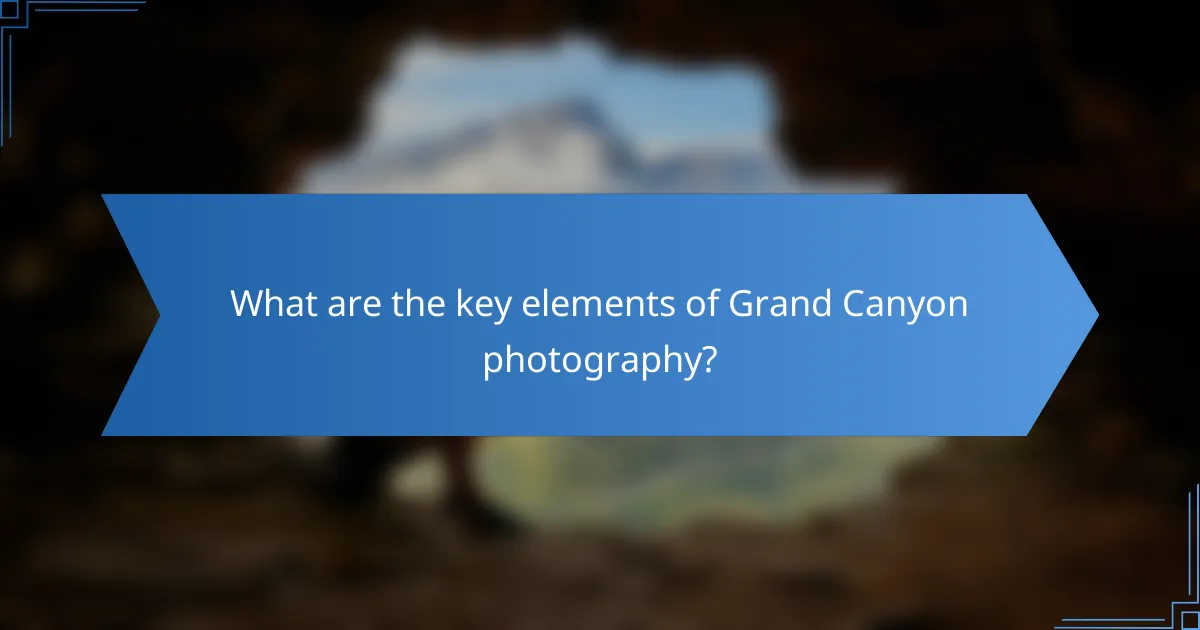
What are the key elements of Grand Canyon photography?
Key elements of Grand Canyon photography include composition, lighting, and timing. Effective composition highlights the canyon’s vastness and unique rock formations. Optimal lighting, especially during golden hour, enhances colors and shadows. Timing is crucial for capturing the canyon’s changing moods, particularly during sunrise and sunset. Understanding these elements allows photographers to create stunning images that reflect both natural beauty and cultural heritage.
How does lighting impact landscape photography at the Grand Canyon?
Lighting significantly influences landscape photography at the Grand Canyon by enhancing colors, depth, and mood. The golden hours of sunrise and sunset create dramatic contrasts, revealing the canyon’s intricate textures and vibrant hues. Midday lighting can flatten the scene, making details less pronounced. Photographers often seek softer light during these times for optimal results. Additionally, weather conditions like clouds or storms can produce unique lighting effects, adding drama to images. Understanding these dynamics is essential for capturing the Grand Canyon’s natural beauty effectively.
Which camera settings are ideal for capturing the canyon’s vastness?
To capture the Grand Canyon’s vastness effectively, use a wide-angle lens with a low ISO setting. Set the aperture between f/8 and f/16 for depth of field. Utilize a tripod to stabilize long exposures, especially during sunrise or sunset for optimal lighting. Adjust shutter speed based on available light, aiming for slower speeds to enhance detail in shadows and highlights.
What compositions work best for Grand Canyon landscapes?
Grand Canyon landscapes benefit from compositions that emphasize depth and scale. Use foreground elements, such as rocks or plants, to create layers and enhance perspective. The golden hour provides optimal lighting, highlighting colors and textures. Wide-angle lenses capture expansive views, while telephoto lenses focus on distant features. Incorporating leading lines directs the viewer’s eye, enhancing visual interest. Consider the rule of thirds to balance elements and create dynamic scenes.
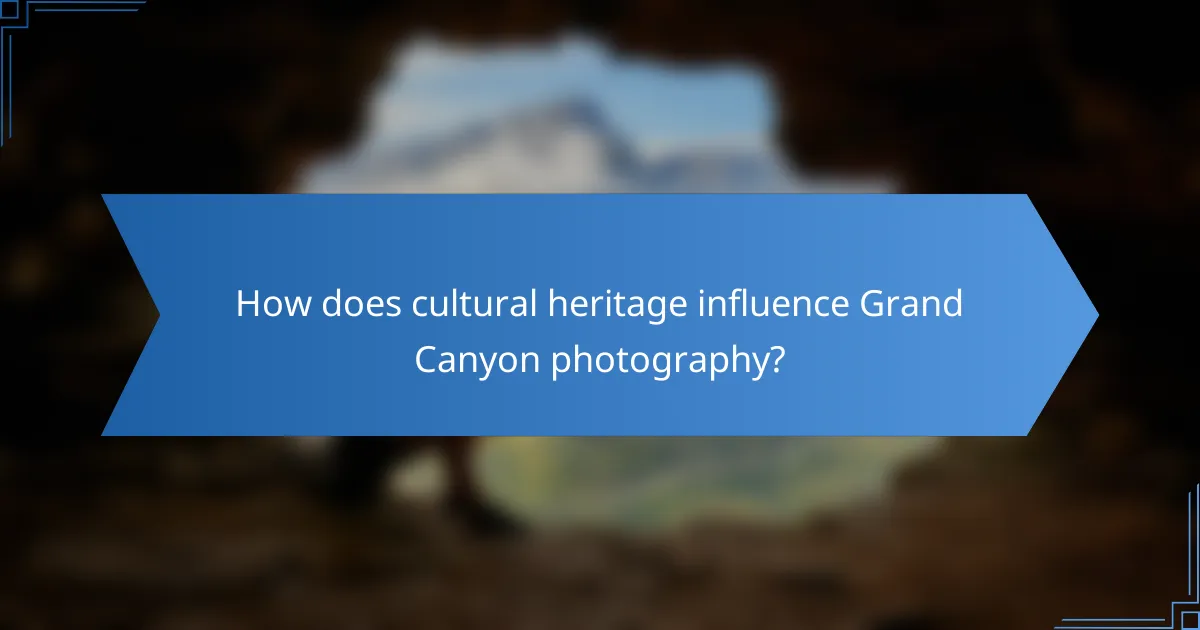
How does cultural heritage influence Grand Canyon photography?
Cultural heritage significantly enriches Grand Canyon photography by providing deeper narratives and context. Photographers capture not only the stunning landscapes but also the historical and cultural significance of the region. For instance, Native American traditions and stories influence composition and subject matter, highlighting the connection between the land and its original inhabitants. This cultural lens adds layers of meaning to photographs, transforming them from mere images into visual storytelling. As a result, photographers often seek to represent both the natural beauty and the cultural heritage, creating a more holistic portrayal of the Grand Canyon.
Which indigenous perspectives are important in Grand Canyon imagery?
Indigenous perspectives in Grand Canyon imagery emphasize cultural significance, spiritual connections, and ecological knowledge. These viewpoints enrich photography by showcasing the landscape’s deep-rooted history and the relationship between Indigenous peoples and the land. Recognizing these perspectives fosters respect and understanding of the Grand Canyon’s cultural heritage.
How can photographers respectfully represent local cultures?
Photographers can respectfully represent local cultures by engaging with communities and understanding their narratives. Building relationships fosters trust and ensures accurate portrayal of cultural heritage.
Respectful representation includes obtaining permission for photography, acknowledging cultural significance, and avoiding stereotypes. Photographers should showcase authentic experiences rather than staged scenarios.
Researching the history and traditions of the culture enhances understanding and sensitivity. Sharing the stories behind the images can deepen appreciation and respect for the subjects portrayed.
Incorporating local perspectives in the creative process enriches the final work. Collaborating with local artists or guides can provide valuable insights and foster a more genuine connection to the culture.
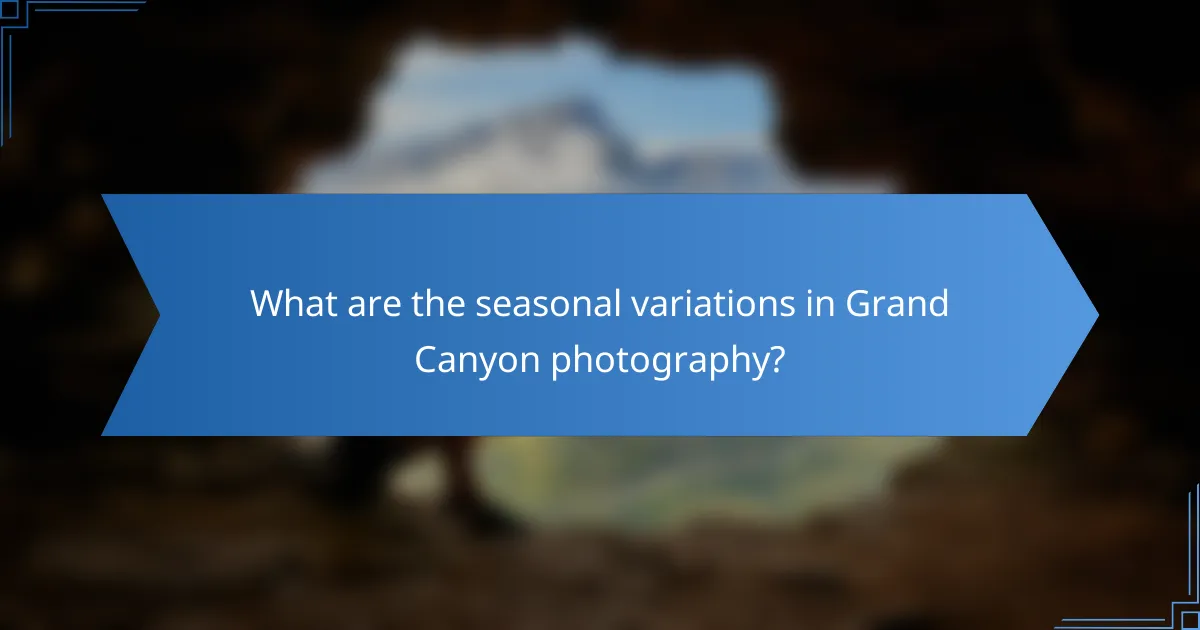
What are the seasonal variations in Grand Canyon photography?
Grand Canyon photography experiences significant seasonal variations that affect lighting, colors, and visitor access. Spring offers vibrant wildflowers and clear skies, enhancing landscape shots. Summer brings dramatic thunderstorms and lush greenery, ideal for capturing dynamic weather. Autumn showcases stunning foliage changes, providing rich colors against the canyon’s backdrop. Winter presents a unique opportunity for snow-capped vistas, creating stark contrasts and serene scenes. Each season offers distinct attributes, enriching the photographic experience.
How does each season affect the canyon’s colors and lighting?
Each season dramatically alters the Grand Canyon’s colors and lighting. In spring, vibrant wildflowers bloom, enhancing the canyon’s hues. Summer sunlight creates stark contrasts, illuminating rock layers. Fall introduces warm tones, with leaves changing color, while winter blankets the canyon in snow, softening its appearance. These seasonal shifts offer diverse photographic opportunities.
Which seasonal events can enhance photography opportunities?
Seasonal events like spring wildflower blooms and autumn foliage enhance photography opportunities at the Grand Canyon. These events create vibrant landscapes, showcasing the canyon’s natural beauty and cultural heritage. Spring offers colorful wildflowers, while autumn features breathtaking fall colors. Summer monsoons can create dramatic skies, adding depth to photographs. Winter snow transforms the canyon into a serene wonderland, providing unique perspectives for photographers.
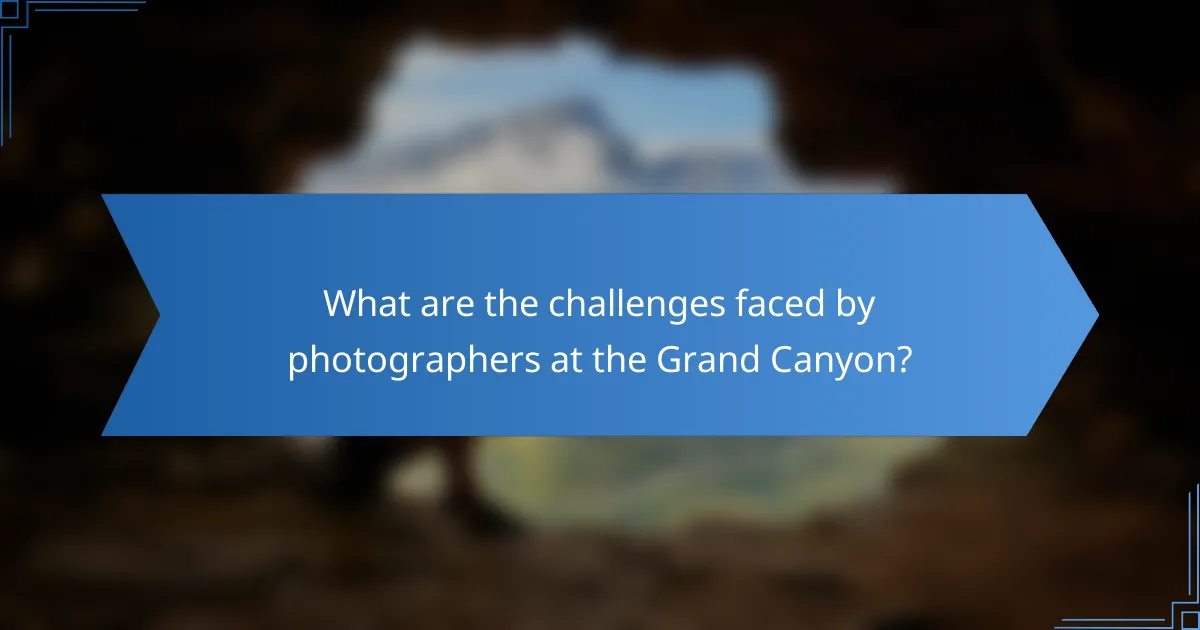
What are the challenges faced by photographers at the Grand Canyon?
Photographers at the Grand Canyon face several challenges. First, unpredictable weather can affect lighting and visibility. Second, the vastness of the landscape makes it difficult to capture the scale and detail effectively. Third, access to certain viewpoints may involve strenuous hikes or limited permits. Additionally, the presence of crowds can detract from the experience and complicate composition. Finally, wildlife encounters can pose both opportunities and risks during shoots.
How do weather conditions affect shooting plans?
Weather conditions significantly influence shooting plans for Grand Canyon photography. Factors like lighting, cloud cover, and precipitation can enhance or hinder the quality of images.
For instance, golden hour light creates stunning landscapes, while overcast skies can produce soft, diffused lighting ideal for capturing details. Wind can affect stability, requiring tripods for clear shots.
Additionally, seasonal changes impact accessibility and scenery. Spring blooms and autumn foliage offer unique visual opportunities, while summer heat may limit outdoor shooting times.
Planning around these weather variables ensures optimal conditions for capturing the Grand Canyon’s natural wonders and cultural heritage insights.
What safety considerations should photographers keep in mind?
Photographers should prioritize safety by being aware of their surroundings, weather conditions, and wildlife. Proper equipment and knowledge of the terrain are essential for safe navigation. Staying hydrated and using sun protection can prevent health issues. Communicating plans with others ensures assistance in case of emergencies.

What unique perspectives can be captured at the Grand Canyon?
The Grand Canyon offers unique perspectives through its diverse geological formations, vibrant colors, and rich cultural history. Photographers can capture breathtaking views from various vantage points, such as the South Rim and North Rim. The interplay of light during sunrise and sunset creates dramatic landscapes, enhancing the canyon’s natural beauty. Additionally, the presence of Native American heritage provides cultural insights, allowing photographers to document both natural wonders and historical significance.
Which viewpoints offer the most dramatic shots?
The viewpoints that offer the most dramatic shots of the Grand Canyon include the South Rim, North Rim, Desert View Watchtower, and Toroweap Point. Each location provides unique perspectives that highlight the canyon’s vastness and intricate geological features.
The South Rim is the most accessible and popular, featuring iconic vistas like Mather Point. The North Rim, less crowded, offers a more secluded experience with stunning overlooks such as Bright Angel Point. Desert View Watchtower provides a panoramic view of the Colorado River and the Painted Desert. Toroweap Point, known for its breathtaking drop-offs, delivers a striking perspective of the canyon’s depth.
These viewpoints cater to various photography styles, from wide landscapes to intimate details, ensuring a comprehensive capture of the Grand Canyon’s natural beauty.
How can drone photography provide a different angle on the canyon?
Drone photography offers a unique perspective on the Grand Canyon by capturing its vastness and intricate details from above. This aerial view reveals the canyon’s layered rock formations and expansive landscapes that ground-level photography often misses. Drones can access remote areas, showcasing hidden features like waterfalls and geological formations. Additionally, the ability to capture dynamic lighting during sunrise or sunset enhances the visual impact, offering dramatic contrasts and rich colors. This method enriches the storytelling of the canyon’s natural wonders and cultural heritage.
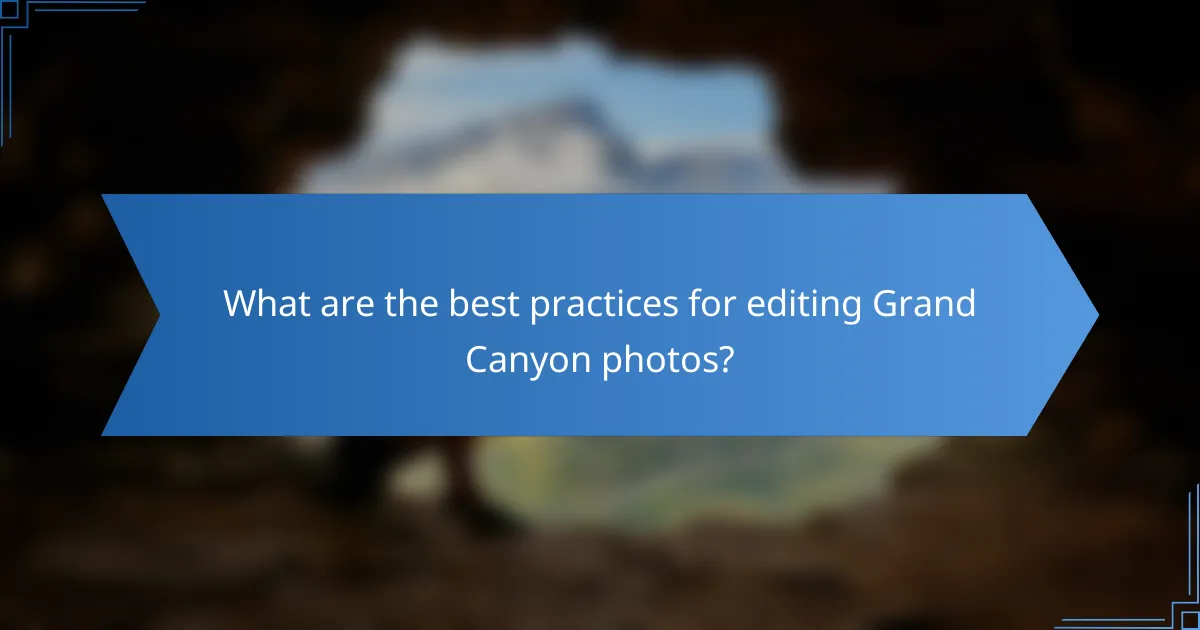
What are the best practices for editing Grand Canyon photos?
To edit Grand Canyon photos effectively, focus on enhancing natural colors and contrasts. Utilize software tools to adjust exposure, saturation, and sharpness for clarity. Incorporate cropping to highlight key elements and maintain the composition’s balance. Consider adding filters to evoke specific moods, but keep edits subtle to preserve authenticity.
Which editing techniques enhance the natural beauty of canyon landscapes?
Editing techniques that enhance the natural beauty of canyon landscapes include high dynamic range (HDR) imaging, color grading, and selective focus. HDR captures a wider range of light, revealing details in both shadows and highlights. Color grading enhances the vibrant hues of the rock formations and sky, creating a more dramatic effect. Selective focus draws attention to specific elements, emphasizing the grandeur of the landscape. These techniques collectively highlight the unique attributes of canyon photography, showcasing their stunning visual appeal.
What common mistakes should be avoided in post-processing?
Common mistakes in post-processing Grand Canyon photography include over-editing, neglecting color balance, ignoring composition, and failing to maintain consistency. Over-editing can lead to unnatural images, while poor color balance detracts from the natural beauty. Ignoring composition issues can result in unbalanced photos, and inconsistency across edits can confuse viewers. Aim for a polished yet authentic representation of the Grand Canyon’s stunning landscapes and cultural heritage.
How can photographers create a cohesive portfolio of canyon images?
Photographers can create a cohesive portfolio of canyon images by focusing on specific themes, techniques, and storytelling elements. Consistent lighting and color palettes enhance visual unity.
Incorporating various perspectives, such as aerial shots or close-ups of textures, adds depth. Emphasizing cultural heritage through local narratives enriches the portfolio’s context.
Regularly curating and updating the collection based on feedback helps maintain relevance. Finally, showcasing the portfolio in a well-designed online platform can attract a wider audience.